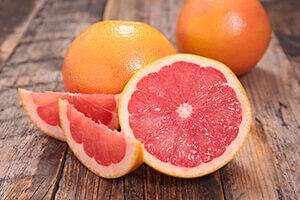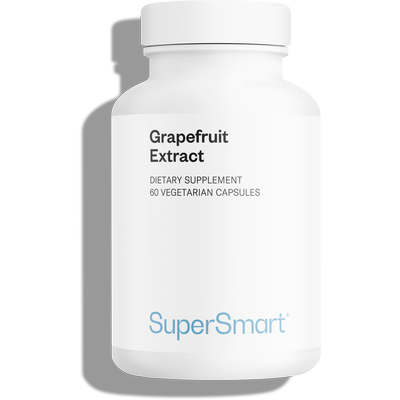17-12-2018
The exceptional properties of grapefruit
 You may have already heard about the benefits of the citrus fruit pomelo. Prized for its nutritional content and health benefits, pomelo is often confused with grapefruit, its close relative. Grapefruit, or to give it its scientific name Citrus paradisi, is widely consumed in the West whereas pomelo is mainly grown and sold in Asia. The two fruits differ in several ways including structure, taste and use. Grapefruit has a thinner skin and sweeter taste than pomelo and is usually consumed raw or as a juice, while pomelo is primarily used for cooking. However, since grapefruit is a hybrid – the result of crossing a pomelo tree with an orange tree - there are commonalities between the two. This explains the similarities between the benefits of grapefruit and those of pomelo and orange, and why they are attracting interest among the scientific community.
You may have already heard about the benefits of the citrus fruit pomelo. Prized for its nutritional content and health benefits, pomelo is often confused with grapefruit, its close relative. Grapefruit, or to give it its scientific name Citrus paradisi, is widely consumed in the West whereas pomelo is mainly grown and sold in Asia. The two fruits differ in several ways including structure, taste and use. Grapefruit has a thinner skin and sweeter taste than pomelo and is usually consumed raw or as a juice, while pomelo is primarily used for cooking. However, since grapefruit is a hybrid – the result of crossing a pomelo tree with an orange tree - there are commonalities between the two. This explains the similarities between the benefits of grapefruit and those of pomelo and orange, and why they are attracting interest among the scientific community.
Nutritional properties and benefits of grapefruit
Though the health benefits of oranges and pomelos may be more widely-known, it appears that grapefruit offers very similar advantages. As with all citrus fruit, the grapefruit boasts excellent nutritional properties. It is brimming with nutrients and vitamins such as vitamin C, renowned for its antioxidant potency and benefits for human health. However, the many scientific studies conducted on grapefruit suggest its virtues do not stop there.
Rich in flavonoids with antioxidant and cyto-protective effects
The complex mix of active principles found in the Citrus genre to which pomelo and grapefruit belong has led to an increase in scientific interest in these fruits over the last hundred years or so 1. Of particular scientific interest are the polyphenols, or more specifically the flavonoids, which are known for their considerable antioxidant potency, and thus huge therapeutic potential for protecting cells against free radical damage and cellular ageing. Scientists have therefore been working to quantify and identify the flavonoids present in grapefruit. Results published in the journal Oxidative Medicine and Cellular Longevity, have highlighted 13 different flavonoids, the most significant of which are naringin and isonaringin2. According to the researchers behind this study, the bioactivity of these flavonoids gives grapefruit excellent antioxidant properties and strong cyto-protective effects – ie, effects that protect cells from harmful aggressors.
A source of the powerful flavonoid naringin
A number of studies have identified grapefruit as a rich source of naringin, a flavonoid studied extensively over recent years for its many health benefits. Indeed, findings on this flavonoid were summarised in a review of the scientific literature published inPharmaceutical Biology 3. Naringin may have a particular role in modulating several of the body’s signalling pathways, giving it a number of pharmacological effects including anti-inflammatory and bone-regenerating activity. The review’s authors also believe it helps counter the oxidative stress responsible for cellular ageing, as well as metabolic syndrome, certain genetic damage and forms of cancer, and diseases of the central nervous system. Another review published in i>Planta Medica highlights naringin’s therapeutic potential for combatting atherosclerosis, cardiovascular problems, diabetes, neurodegenerative disorders, osteoporosis and rheumatologic illnesses4.
Grapefruit’s anti-microbial effect
In addition to its considerable antioxidant potency, grapefruit may also possess an anti-microbial effect, according to two studies published in the journal Journal of Alternative and Complementary Medicine5,6. Using a grapefruit extract, this effect was observed against several strains of bacteria. In-depth analysis showed that certain active principles in grapefruit disrupt the bacterial membrane, potentially reducing bacterial activity and in some cases, killing the bacteria. The studies’ authors also mentioned other reports that indicate even greater anti-microbial effects for grapefruit extract. According to this data, it may be effective against 800 strains of bacteria and virus, 100 types of fungus, and a wide range of parasites.
Research demonstrates therapeutic potential of grapefruit
As more and more is discovered about the grapefruit, a number of researchers have begun to investigate its therapeutic potential. Studies have focused primarily on naringin’s effects and the anti-microbial activity observed with the use of grapefruit extract.
Grapefruit for the treatment of urinary infections
A study which appeared in the Journal of Alternative and Complementary Medicine suggests that grapefruit may have a positive effect in the treatment of urinary infections7. Conducted at the Wesley Guild Hospital in Nigeria, the study investigated four patients diagnosed with infection of the urinary tract. Each patient presented with a different strain of bacteria: Pseudomonas aeruginosa, Klebsiella species, Staphylococcus aureus and Escherichia coli. After two weeks’ oral treatment with grapefruit seeds, researchers observed a positive response in three of the four patients. In the fourth, infected with Pseudomonas aeruginosa, the grapefruit seeds did not eliminate the bacteria, but it did produce an unexpected result – that of reversing the initial resistance of the bacteria to antibiotic treatment. These preliminary findings suggest grapefruit offers therapeutic potential in treating urinary infections.
Grapefruit’s anti-inflammatory effect in the gut
In addition to this anti-microbial role, scientists have also examined grapefruit’s anti-inflammatory effects. A study assessing the fruit’s potential for treating certain inflammatory diseases was published in the Pakistan Journal of Pharmaceutical Sciences 8. Researchers examined the effects of a grapefruit extract, administered either on its own or in combination with an extract of orange, to rats with acute colitis (inflammation of the colon). They found the grapefruit extract reduced the development of inflammatory lesions and incidence of diarrhoea, and restored levels of glutathione, a molecule recognised as one of the body’s most powerful antioxidants, as described in our article on the vital role of gluthatione. These preliminary results are highly encouraging and suggest grapefruit could have beneficial effects in treating inflammatory diseases.
Grapefruit may modulate lipid metabolism in obese rats
Grapefruit may also be useful in preventing certain lipid-related diseases according to a study published in the journal Food & Function. Researchers studied the effects of grapefruit consumption in obese rats9 and found that administration of the fruit prevented fatty tissue from accumulating in the liver and reduced the expression of two hepatic genes involved in lipogenesis. In other words, consuming grapefruit may help reduce the formation of fats. In addition, grapefruit’s components increased the expression of a hepatic gene involved in mitochondrial consumption of fatty acids. The research also showed a decrease in free radical damage, enhanced liver enzyme activity and protection of hepatic lipids and proteins. If these results are replicated in humans, grapefruit could prove to be a useful weapon in the fight against obesity.
Could naringin offer new hope in treating metabolic syndrome?
As well as demonstrating positive findings in obese rats, scientists have also been investigating the use of grapefruit in combatting metabolic syndrome10. This is a collection of physiological symptoms, including excess weight and obesity, which if left untreated, can lead to health complications such as the onset of diabetes or cardiovascular disease. Published in the journal Advances in Nutrition, this animal model study on grapefruit’s potential to combat metabolic syndrome demonstrated a number of beneficial effects for naringin. It may positively affect several of the body’s physiological processes involved in fat consumption. These findings now need to be confirmed by human studies.
Long-valued for its taste, grapefruit is now being championed by the scientific community for its many health benefits. With its high nutritional value and presence of several active principles, grapefruit could prove to be a major aid to maintaining good health. The active principle naringin offers particular potential here which is why a grapefruit extract standardised to 99% naringin has been developed for use as a dietary supplement. .
Sources :
1. Rouseff RL, Ruiz Perez-Cacho P, Jabalpurwala F, « Historical review of citrus flavor research during the past 100 years », J Agric Food Chem, 2009 Sep 23, 57(18):8115-24.
2. Castro-Vazquez L, Alañón ME, Rodríguez-Robledo V, Pérez-Coello MS, Hermosín-Gutierrez I, Díaz-Maroto MC, Jordán J, Galindo MF, Arroyo-Jiménez Mdel M, « Bioactive Flavonoids, Antioxidant Behaviour, and Cytoprotective Effects of Dried Grapefruit Peels (Citrus paradisi Macf.) », Oxid Med Cell Longev, 2016, 2016:8915729.
3. Chen R, Qi QL, Wang MT, Li QY, « Therapeutic potential of naringin: an overview », Pharm Biol, 2016 Dec, 54(12):3203-3210.
4. Bharti S, Rani N, Krishnamurthy B, Arya DS, « Preclinical evidence for the pharmacological actions of naringin: a review », Planta Med, 2014 Apr, 80(6):437-51.
5. Reagor L, Gusman J, McCoy L, Carino E, Heggers JP, « The effectiveness of processed grapefruit-seed extract as an antibacterial agent: I. An in vitro agar assay », J Altern Complement Med, 2002 Jun, 8(3):325-32.
6. Heggers JP, Cottingham J, Gusman J, Reagor L, McCoy L, Carino E, Cox R, Zhao JG, « The effectiveness of processed grapefruit-seed extract as an antibacterial agent: II. Mechanism of action and in vitro toxicity », J Altern Complement Med, 2002 Jun, 8(3):333-40.
7. Oyelami OA, Agbakwuru EA, Adeyemi LA, Adedeji GB, « The effectiveness of grapefruit (Citrus paradisi) seeds in treating urinary tract infections », J Altern Complement Med, 2005 Apr, 11(2):369-71.
8. Khan RA, Mallick N, Feroz Z, « Anti-inflammatory effects of Citrus sinensis L., Citrus paradisi L. and their combinations », Pak J Pharm Sci, 2016 May, 29(3):843-52.
9. Gamboa-Gómez C, Salgado LM, González-Gallardo A, Ramos-Gómez M, Loarca-Piña G, Reynoso-Camacho R, « Consumption of Ocimum sanctum L. and Citrus paradisi infusions modulates lipid metabolism and insulin resistance in obese rats », Food Funct, 2014 May, 5(5):927-35.
10. M. Ashraful Alam, Nusrat Subhan, M. Mahbubur Rahman, Shaikh J. Uddin, Hasan M. Reza, and Satyajit D. Sarker, « Effect of Citrus Flavonoids, Naringin and Naringenin, on Metabolic Syndrome and Their Mechanisms of Action », Adv Nutr, 2014 Jul, 5(4): 404–417.
Order the nutrient mentioned in this article
Further reading
24-06-2019
Better known as PEA, palmitoylethanolamide is a natural and powerful active principle discovered in 1957. Since then, it has consistently been the subject of new...
Read more04-09-2019
Did you know that of all your organs, it is the lungs which are the first to age? Like the skin, they are exposed to...
Read more03-01-2018
Every year, the same people seem to miraculously escape the epidemics of flu or gastroenteritis. The fact is though, luck has nothing to do with...
Read more© 1997-2025 Fondation pour le Libre Choix
All rights reserved
All rights reserved
Free
Thank you for visiting our site. Before you go
REGISTER WITHClub SuperSmart
And take advantage
of exclusive benefits:
of exclusive benefits:
- Free: our weekly science-based newsletter "Nutranews"
- Special offers for club members only


















